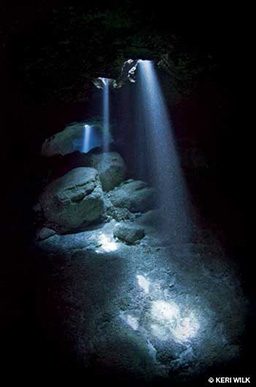
In March 2011 an earthquake off Japan’s coast with a magnitude of 9.0 sent a tsunami raging away from its epicenter in all directions. Japan, of course, got the worst of it, but the 7-foot-high wall of water that pounded the western coast of Hawaii Island was no laughing matter. It caused millions of dollars in damage and even shut down some businesses permanently. I arrived on the island just a few hours after this devastating event, so I fully expected the diving conditions to be grim. I couldn’t have been more wrong.
Much like the island’s community, which has a long history of rebounding from natural disasters with renewed resilience, the rugged, volcanic western coastline of Hawaii’s Big Island proved to be more than a match for the tsunami.
Without much coastal sand or soil to run off into the ocean, it was typical for us to have visibility of more than 100 feet, even just a few hours after the massive waves hit. The boulder-strewn underwater scenery is heavily encrusted with hard corals and has a unique aesthetic compared to any other Pacific destination I’ve encountered.
While Kona isn’t a go-to destination for massive schools of fish, expansive fields of soft coral or pygmy seahorses, it has its own signature set of underwater attractions that make it well worth a trip.
Lava Tubes
When molten lava below the earth’s surface is forced out during an eruption, it is typically either ejected violently or allowed to slowly ooze out like blood from a wounded earth. When conditions are just right, the outer surface of slow-moving lava will harden while still allowing internal flow to continue. When the source of the lava runs dry, the hard outer crust remains, and a hollow, underground “lava tube” is formed, resulting in a peculiar bathymetric feature for divers to explore.
Sometimes as wide as a truck and several hundred yards long, lava tubes are not only beautiful geological formations but also serve as sheltered habitat for encrusting sponges, corals, flatworms and myriad other marine creatures.
Kona’s northernmost dive site, Kalokos Arches, has several such formations, some of which are partially collapsed, which makes for large, photogenic swim-throughs.
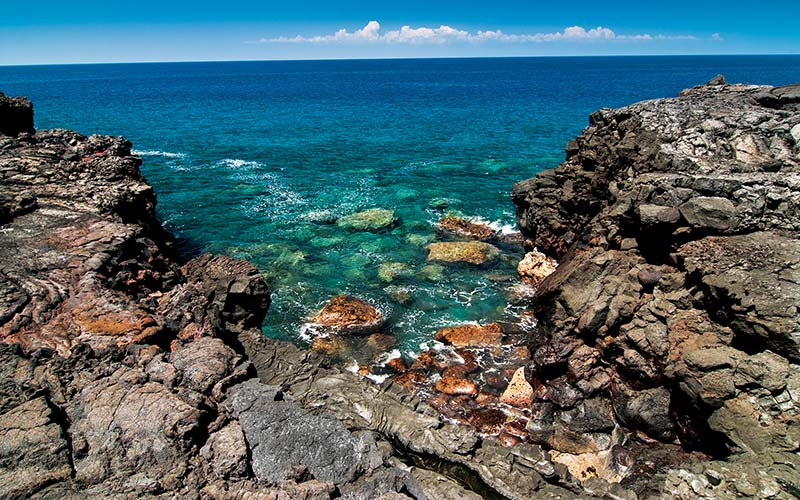
Turtle Cleaning Stations
If close encounters with sea turtles are your cup of tea, then you should check out Turtle Pinnacle. Turtles are constantly drawn to this site in the hope of getting parasites and shell-algae removed by cleaner fish. They typically swim past the cleaning station very slowly, making several passes until their hygiene level is where they want it. Sometimes, however, they’ll just drop down onto the reef, close their eyes and enjoy a full spa treatment until they need to surface for air. I’m hard pressed to think of another destination where such reliable and intimate encounters with turtles can be achieved so easily.
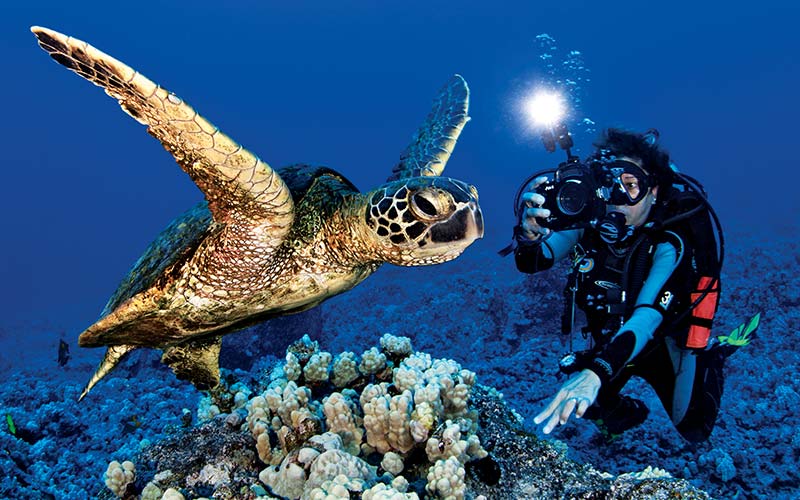
Mantas
For decades, even before diving became mainstream, bright lights from oceanside restaurants along the Kona coast have been attracting mantas close to shore, a phenomenon the proprietors didn’t fully appreciate for many years. Eventually, in the early 1990s dive operators began to recognize the extraordinary nature of these nightly gatherings, and they started taking groups of divers to experience unparalleled face-to-face encounters with the gentle creatures. Now Kona’s iconic manta night dive is one of the most well-known dives in the world.
As if gathered around a campfire, divers sit in a circle on a sandy bottom around light boxes and point their flashlights toward the surface, attracting plankton en masse. Almost without fail, mantas — sometimes as many as 20 at a time — come to claim their free dinner and perform feeding somersaults mere inches from your head. How an animal so large can move with such precision and grace is beyond my comprehension.
Although mantas can be found along the entire coast, sightings are the most consistent and plentiful at Garden Eel Cove.
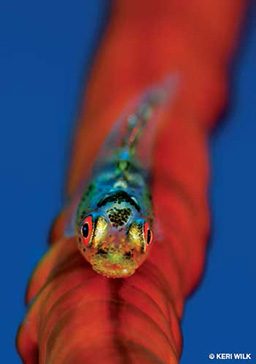
Blackwater Dives
Diving several miles offshore over thousands of feet of water isn’t everybody’s idea of fun, especially not in the middle of the night. But that’s exactly what Kona’s “blackwater” night dives are all about.
Countless species of abyssal invertebrates spend their days deep beyond the reach of sunlight and so are seldom seen by recreational divers. However, when night falls, many of these peculiar animals venture up the water column, presumably in search of food.
This dive consists primarily of waiting, staring and drifting below the boat with the current of the open ocean. As you scan the unknown with your flashlight beam, it reveals countless small, translucent animals, each more fascinating than the last. Whether you are hoping for some unique photographs or are simply interested in seeing some marvels of evolution, this dive is highly recommended, and it can be done just about anywhere in Kona’s rich waters.
Dolphins
If eerie oceanic night dives with tiny, otherworldly invertebrates isn’t your thing, Kona also has plenty at the other end of the diving spectrum — like friendly dolphins in clear, sunny, shallow water.
Some sheltered bays on the island’s west coast serve as playgrounds for several pods of spinner dolphins. They can often be seen leaping high out of the water. The songs of humpback whales are also frequently heard, but in-water encounters with them are heavily restricted. Thankfully, no such red tape exists for dolphins.

Underwater, the dolphins’ clicks, whistles and squeaks seem to come from all directions, so it’s important to stay alert and watchful. When their faint silhouettes appear in the distance, your first instinct might be to kick frantically toward them for a closer look. Don’t. Suppress the urge, and force yourself to wait. But if you must move toward them, do so slowly and calmly. You wouldn’t want a dolphin with legs to charge at you and your family while you’re walking through the park, would you? Patience often pays off — curious young pod members will sometimes break from the safety of the pod to investigate you while swimming dizzying circles around you.
How to Dive It
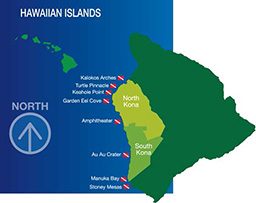
Conditions: Regardless of when you travel to Kona, expect air temperatures to be between 75°F and 80°F. Water temperatures are in the low- to mid-70s during the winter; they rise to the low 80s in late summer and early fall (August to October). A 3mm or 5mm wetsuit is recommended, and for heavy repetitive diving you may also want to bring a hood. Being sheltered on the lee side of Hawaii, Kona’s surface conditions are usually suitable for diving. It’s common to have more than 350 diveable days a year, the exceptions being due to short-lived winter storms. With few river outlets and almost no coastal sand to spoil water clarity, visibility is consistently greater than 100 feet.
Getting There: Direct flights from Los Angeles, San Jose, San Francisco, Oakland and Seattle can get you to Kona in five to six hours, typically for less than $500. To maximize dive time, avoid flights that connect through Honolulu, as these can sometimes double the total travel time. Kona’s international airport is right on the coast with dive operators scattered on either side of it.
On the Surface: If time permits, rent a car. Hawaii Island offers a multitude of easily accessible attractions such as volcanoes, waterfalls, beaches, national parks, nature trails and historic villages.
General Recommendations: The water gets deep quickly off Kona’s coast, making shore dives on rich reefs possible. There are numerous dive operators running day boats to popular sites, but for the most convenient diving experience, consider a trip on one of the area’s liveaboards. To optimize bottom time and range, a liveaboard is a terrific option.
Explore More
© Alert Diver — Q2 Spring 2013